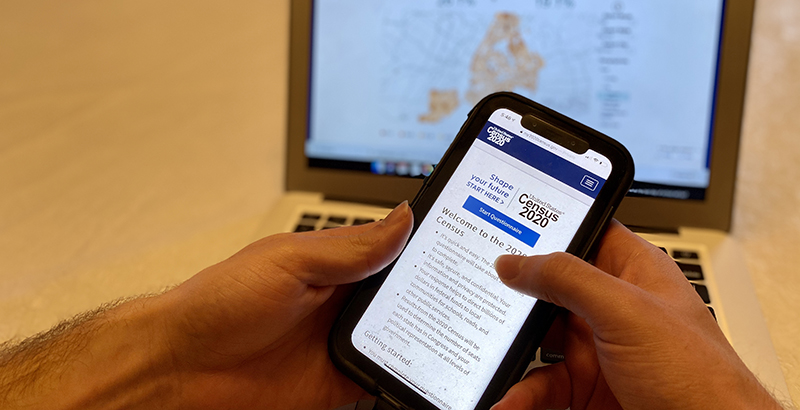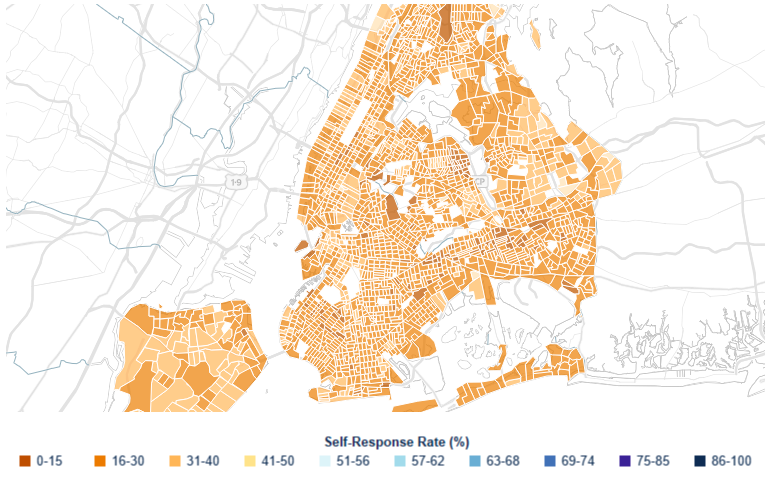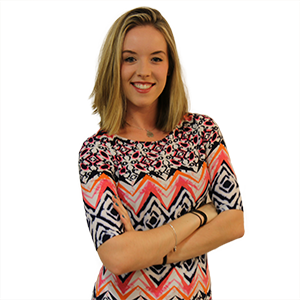As Coronavirus Consumes Public Attention, NYC Advocates Remind Residents of a Vital School Revenue Stream: The 2020 Census

On March 12, the website and phone lines for the 2020 U.S. Census went live. That same day, New York City Mayor Bill de Blasio declared a state of emergency to battle the coronavirus.
The initial rollout of the decennial census, a once-a-decade U.S. population and housing count, has run head-on into the spread of COVID-19 — an unprecedented pandemic that has consumed the public’s attention, crippled the U.S. and world economy and upended the nation’s education system. Like other districts, NYC’s, the country’s largest, with 1.1 million students, is piloting a herculean transition to remote learning that’s already overwhelming many parents and educators.
Despite the public’s attention being focused elsewhere and much of their outreach strategy precluded, city officials and community groups remain resolute on keeping the nine–question census form top of mind for New Yorkers. They know what’s at stake: the number of people counted, especially often overlooked young children, dictates how millions and billions in federal funding is funneled to areas such as public education and school-related services, like free and reduced-price lunch. That money will be especially crucial as the coronavirus further strains the state’s budget.
“That child in 2010 who was not counted, who entered kindergarten, is not counted again until they’re a sophomore in high school,” said Julie Menin, director of NYC Census 2020, the city’s census outreach arm. Around 70,000 NYC children under age 5 went uncounted in 2010, according to data compiled by the Citizens’ Committee for Children of New York. “It’s a once-in-every-10-years snapshot. … We cannot afford to have anyone not fill this out.”
The reference day for the census is April 1, the day respondents count the number of people living in their house and a major campaigning moment nationwide ensues, known as “Census Day.” Reporting now runs through mid-August following a federal extension.
Unable to conduct in-person, door-to-door grassroots efforts because of COVID-19, local organizations have shifted gears to relying on phone banks, texting, TV ads, social media, efforts by youth advocates and even an old staple — print — to get out the message. Outreach remains especially critical for about 53.3 percent of city households that are considered “hard to count,” such as those with no internet, with non-English speakers or with immigrant families fearing government punishment.
“We were going to do daily street outreach where we would have our young people out in the community handing out literature about the census,” said Milan Taylor, founder of Rockaway Youth Task Force, a student-led group involved in census campaigning. “We’ve had to transform our strategy completely.”
About 26 percent of NYC residents had filled out the census as of Tuesday, with average reporting rates by borough ranging from 24.3 percent in Brooklyn to 30.2 percent on Staten Island, NYC Census 2020 reported.

The lowest-performing neighborhoods as of Monday included North Corona, Queens, with 11.3 percent and Cypress Hills, Brooklyn, at 15.3 percent.
Why the census matters for schools
Federal agencies use the results of each decennial census to distribute what is now more than $675 billion in funds annually to spend on schools, hospitals, affordable housing, roads and bridges and other vital programs.
Looking specifically at public education, NYC receives about $1.5 billion a year based on its 2010 census data, according to NYC Census 2020. That includes about $781 million toward Title I grants to support low-income students, $270 million to special education and $67 million to Head Start, an early childhood education program.
This funding “is critically important,” especially “in communities of concentrated poverty,” said Lemuria Alawode-El, vice president of United Way of NYC’s Strengthen NYC unit, which is helping to manage outreach efforts citywide. She added that census counts also determine “professional development funds for teachers, funds that support school lunch. … They also make a difference in how many schools are in a community.”
NYC Census 2020 couldn’t provide an estimate of how much money the school system forgoes when one child isn’t counted. (Officials in Houston, the largest city in Texas, recently estimated that $1,000 in federal funding is lost for every uncounted individual.)
Any extra federal dollars could be especially needed in the current climate. New York state is faced with tightening its purse strings as the coronavirus-era economy continues to nosedive. Independent of the pandemic, cities in New York have steadily had to shoulder a larger portion of funding for their schools — now about 60 percent of the bill — and NYC officials say the state still owes them $1.1 billion under its funding formula.
Boosting turnout with new strategies
Menin, NYC Census 2020’s director, said the goal is the same as before the coronavirus: to get a better census response rate in every city neighborhood than in 2010.
That year, the response rate fell just shy of 62 percent, well below the 76 percent nationwide average.
The census this year is available online and by phone for the first time, which advocates hope will encourage participation. NYC Census 2020 has also spent $19 million of its $40 million budget on grants to 157 community organizations that are heading local outreach efforts.
That game plan, though, looks different now. Because of the blanket closures meant to enforce social distancing, local volunteers can’t knock on doors in the coming weeks or pop into bodegas and hair salons. They can’t visit schools or engage parents as they pick up their kids from an afterschool program or wait for a parent-teacher conference meeting. Public places like libraries and community centers can’t host informational events.
Instead, organizations are using messaging apps like Hustle and Plentiful to contact people directly. United Way of NYC is sharing census-related curriculum for educators now teaching remotely. Organizations like CCC New York are also harnessing the power of students and social media. Its YouthAction program, for example, is hosting a virtual #YouthActionDay2020 event on April 1 for Census Day.
At the city level, Menin said NYC Census 2020 ended plans to open 300 pop-up centers where people could fill out the census and pulled its MTA advertisements amid plummeting subway ridership, among other actions. In their place, the organization is starting up TV advertising this week on channels that “many target people watch — so that can be like Love & Hip Hop,” a spokeswoman on the call noted, referring to the VH1 docuseries. “We’re also going to be showing the ads during the same news conferences that everyone is tuning in to,” like Gov. Andrew Cuomo’s must-see daily pressers.
NYC Census 2020 also held a “Text Out the Count” event on March 22 and March 23, where volunteers sent out text messages to more than 1 million New Yorkers. Youth engagement is a priority, too; the city has enlisted celebrities like rapper Cardi B to join the campaign to encourage widespread sharing of census messaging.
https://twitter.com/iamcardib/status/1243187855255576577?s=20
Alawode-El, vice president of Strengthen NYC, reminded students that they’re able to fill out forms on behalf of their families.
While organizations are getting creative, those tasked with reaching specific, lower-income communities are still mourning the loss of face-to-face interactions.
Iris Cabrera, from the Committee for Hispanic Children & Families, said she’s had a hard time shifting gears to online and text-based messaging using apps like Hustle. Targeted outreach is critical in the South Bronx, where her organization is operating, she says, with many families there already wary of filling out the census form in the wake of President Donald Trump’s anti-immigration rhetoric and his unsuccessful attempt to insert a citizenship question. Others live doubled up with other families and are worried about alerting their landlord. (Information submitted through the census is confidential.)
Although her group, which received $125,000 in grant money from the city, had used its afterschool programs in the Bronx to collect contact information from some 2,000 parents prior to the pandemic, Cabrera worries that this shift only puts up more barriers.
“A lot of these people are mothers; they don’t have the capacity to learn quickly how to use any app,” said Cabrera, the assistant director of community engagement. “Most of them don’t speak a lot of English, so now that we are doing everything through the app, and through internet and computer, it’s been a challenge for me.”
For now, she and about 14 colleagues and volunteers conducting census work dedicate about five hours a day to calling those parents and using the Hustle app to text, asking community members, “Hey, did you complete the census? Do you need help?”
The Rockaway Youth Task Force organization members “really pride ourselves [on] being in the community and of the community,” said Taylor, the founder and executive director. The group, which won $100,000 in city grant money, had planned on engaging “friends, neighbors and family [in conversations] about the census, face-to-face on the streets” in the far-out Queens enclave, home to predominantly lower-income families of color.
With those efforts paralyzed, “our young people spread the word on social media, on their own, but also just amongst their personal networks,” said 19-year-old Andrea Colon, the community engagement organizer. But it’s not all about online messaging now.
“There are populations within our community that don’t have access” to technology and the internet, Taylor pointed out. As a solution, a chunk of the task force’s resources is currently going toward their next quarterly print magazine, The Rockaway Advocate, which will now be chock-full of information on the census.
About 10,000 copies are slated for print in the coming days.
As community organizations recalibrate, Menin from NYC Census 2020 is hopeful — but also keeping a close eye.
“There’s no doubt that our job has been made much more difficult as a result of this, and we’re working literally 24/7, every single day,” she said. “While the first couple weeks have been strong, my one cautionary note is we really still have a lot of work to do.”
The public can fill out the census online at this link here. A digital code is not required, even if one was sent in the mail. People can also complete the census by phone by calling (844) 330-2020. The U.S Census Bureau offers assistance and different phone lines for various languages. You can find those here.
Get stories like these delivered straight to your inbox. Sign up for The 74 Newsletter

;)
